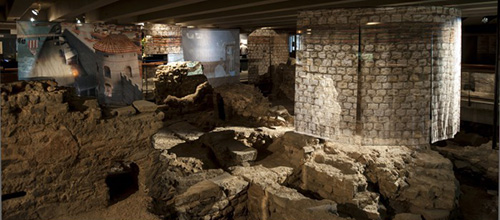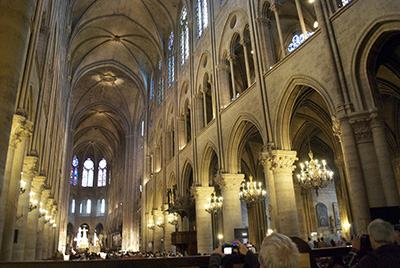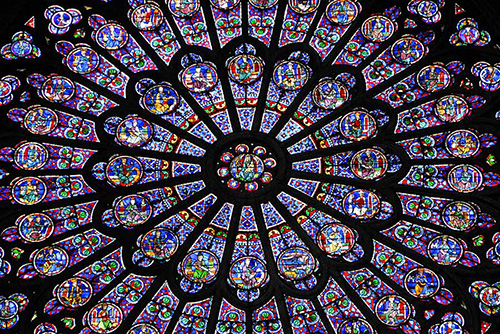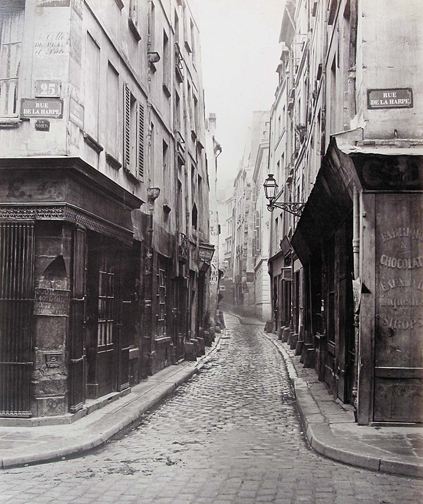Tour of Paris in the High Middle Ages
Background Material to Prepare for Your Part of the Tour
An Overview of Paris in the High Middle Ages
- 'Queen of Cities' 1100-1300 [Colin Jones, Paris: Biography of a City (New York: Viking, 2005), pp.32-37.]
B Crypte Achéologique
In the 1960s a giant underground parking lot was constructed beneath this part of Paris, and some of the ruins of the ancient and medieval city were discovered. The space has been turned into a small museum, where there are traces of Parisian life and exhibits about life in the city in that period, Your team will have time to explore the Crypt, and then you will lead the rest of the class on a tour around the space, sharing with them some of what you learned in researching the period from 1200 to 1550 AD. You can also use the models of the city at various points in its past to talk about how the city changed in the period that you are considering. Since the level of the streets on the Ile de la Cité are much higher than they were in the Middle Ages due to so many centuries of one building being replaced by another, you will be walking amidst the foundations and walls of houses that were once considerably higher than they are today. Once outside you will see in the space between the Crypt and Notre Dame the outlines of these medieval streets that have been marked out on the pavement. Either place (or both) might be a good place to share with your classmates something about life in the crowded neighborhoods of medieval Paris.
|
Walls of Medieval Buildings in the Archaeological Crypt |
B Notre Dame
|
This is, of course, one of the high points of the medieval part of our tour, and you will have a chance to share with your classmates what you have learned about the building and what it tells us about life in Paris in the High Middle Ages. Hopefully, the lines will not be so long that we will have to postpone the tour of the interior. But, even if we do make the circuit within the building, it will necessary to do our talking about it on the pavement outside.
|
C Square René Viviani outside the church Saint-Julien-le-Pauvre
We will have crossed the Seine on the Pont au Double, and we will settle for a bit in a small park in the midst of the Latin Quarter, before we continue on through that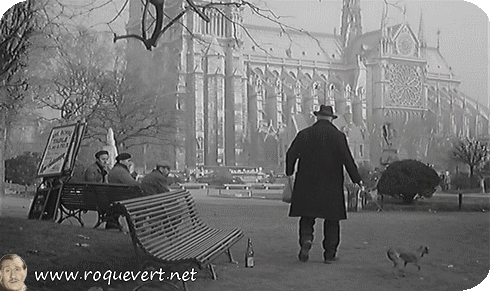 district. This would be a good place to share what you have learned about the medieval university, its students, and anything else you have learned about this area in the Middle Ages. In the square is the oldest tree in Paris (planted 1601) and behind it is what remains of Saint-Julien-le-Pauvre, a church that was built around the same time as Notre Dame.
district. This would be a good place to share what you have learned about the medieval university, its students, and anything else you have learned about this area in the Middle Ages. In the square is the oldest tree in Paris (planted 1601) and behind it is what remains of Saint-Julien-le-Pauvre, a church that was built around the same time as Notre Dame.
Sources:
Petit Pont [Sonia, Alison, and Rebecca Landes, Paris Walks (New York: Henry Holt, 2005), pp.5-6.]
Students on the Street of Straw [Sonia, Alison, and Rebecca Landes, Paris Walks (New York: Henry Holt, 2005), pp.22- 23.]
Between C (Square René Viviani) and D (the ancient Roman Baths)
Charles Marville, Photograph of the Rue de la Parcheminerie, 1865-69 |
We will be wandering through the Latin Quarter (the Quartier Latin) the intellectual center of medieval Europe. Many of the major writers and intellectuals of the period were students or taught here (e.g. Abelard, Aquinas, Dante), and a very active student culture often led to clashes with older Parisians that sometimes resulted in deaths. (The same streets saw massive battles between students and special police during the May 1968 revolt.) We will be passing streets like the Rue de la Parcheminerie, where parchment was sold during the Middle Ages.
|
The Remainder of the Walk
Most of the sites encountered in the remainder of the walk will be discussed by members of the other teams. But there are a couple of spots that you might want to be prepared to mention:
|
Hôtel de Sens (constructed 1474-1519) |
Animation of Paris Across the Centuries
Click here for an presentation of the development of Paris. Animators have imagined what Paris looked like at various periods and created a 13-minute video that allows you to fly through the city in each era. It was, of course, necessary to make guesses about what things must have looked like at various periods, but it is fascinating to get a general idea of how the city has changed visually over more than 2000 years. The section that presents Paris in the period that your group is concentrating on begins just after the 4 minute mark with the construction of Notre Dame.
